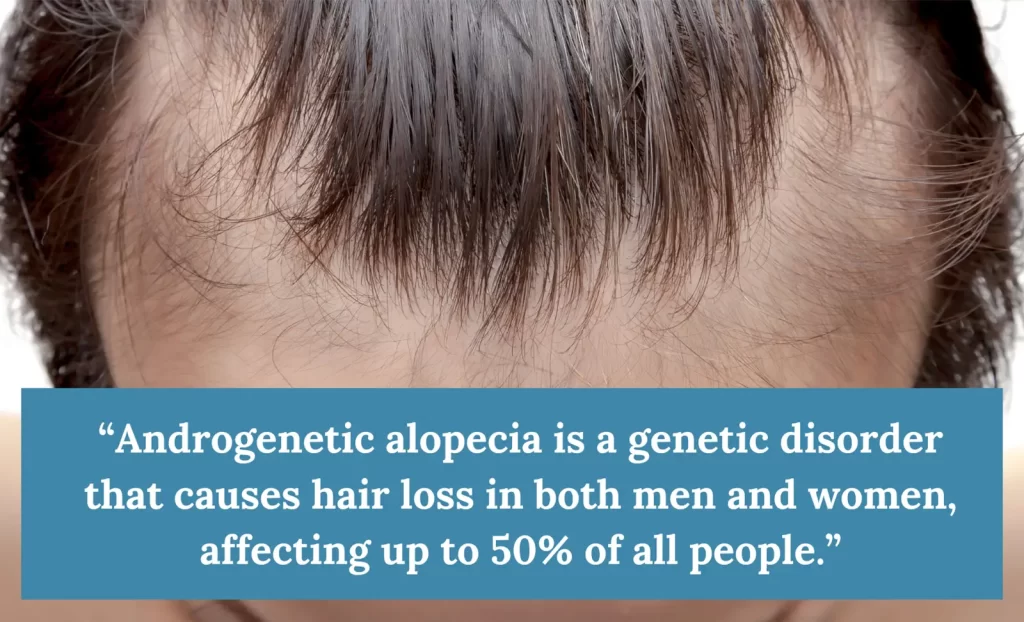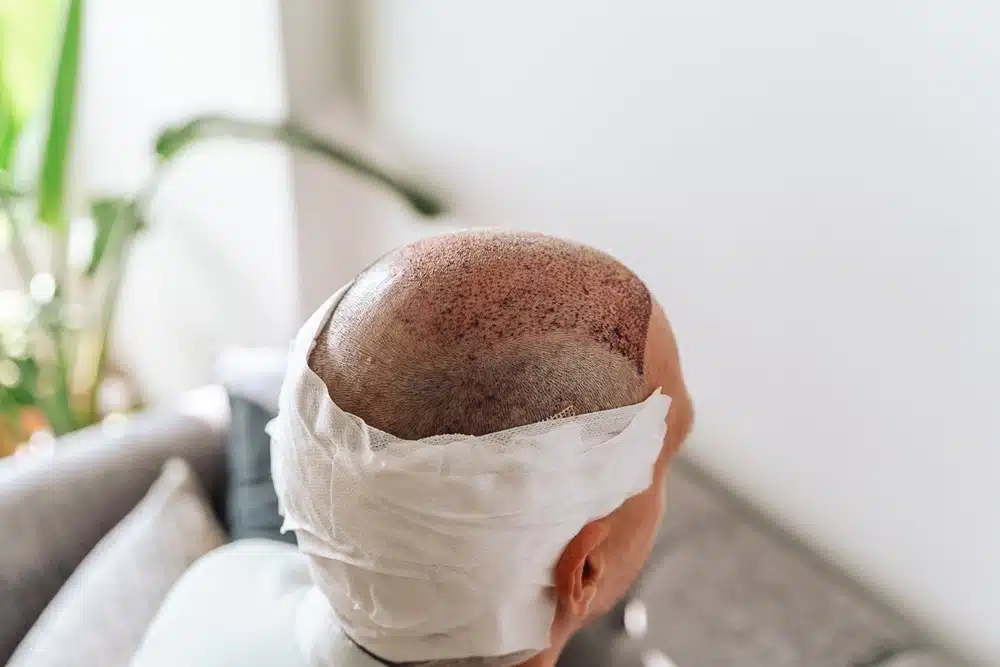Over the years, hair transplants have helped many different people grow back their hair and regain their confidence once more. The procedure itself has come a long way, too. Once, hair transplants were only for the rich and involved noticeable hair plugs. Nowadays, hair transplants are much more attainable by the average person and are refreshingly natural, thanks to the method of extracting only a few follicles at a time.
So, what about if your hair is curly? Many people with wavy or curly hair experience hair loss but aren’t sure whether a hair transplant is an option. You don’t have to wonder any longer! In this article, we’ll explore the curly hair transplant, explaining whether it’s viable, how it works, and who makes a good candidate for the procedure.
What Causes Curly Hair Loss?
Curly hair loss is common. However, it’s not always as noticeable as straight hair loss. That’s because the curls give the appearance of fuller, thicker hair and also do their part in camouflaging the bald/thinning areas. As a result, people with curly hair tend to notice their hair loss much further down the line. When they do, usually it’s one of the following culprits:
Androgenetic Alopecia
Androgenetic alopecia is a genetic disorder that causes hair loss in both men and women, affecting up to 50% of all people [1] (although it is more common in males). In men, it usually results in hair loss at the crown and at the temples, whereas in women, it often leads to a widening parting and hair thinning all around. People with curly hair are just as likely to get androgenetic alopecia as people with straight hair.
Traction Alopecia
It’s common for people with curly hair to pull it back into tighter hairstyles so that they’re easier to manage, such as tight ponytails, braids, and cornrows. This pulls on the hair root over time and leads to bald patches. Unfortunately, this can sometimes lead to permanent loss if the hairstyles are worn continuously for a long time.
Can You Get a Hair Transplant with Curly Hair?
Yes! People with curly or wavy hair can certainly get a curly hair transplant. However, there are some things to keep in mind.
The structure of curly hair is slightly different from straight hair. The curly hair follicle has a spiral shape that goes well into the root, making it more difficult for doctors to graft and leading to higher transection rates. Due to this, surgeons handling a curly hair transplant must be very careful and meticulous, using the highest quality equipment. So – yes, you can get a hair transplant with curly hair, but it’s essential to know the risks and choose an experienced and skilled surgeon who knows how to handle your hair type. Ideally, one who has transplanted curly hair before.
Using the FUT Technique
One of the ways to make a curly hair transplant easier is by using the FUT technique (as opposed to FUE). The FUT (Follicular Unit Transplantation) method is when the surgeon extracts a small strip of skin from the donor area for transplantation. It’s a slightly more straightforward procedure than FUE, which only grafts one follicle at a time. The FUT method works very well for people with curly hair, and patients can expect new hair growth in four months, with full results appearing after 10-18 months. [2]
Will Your Newly Grown Hair Texture Be the Same as Your Own?
Yes. The surgeon will extract hair from the back or sides of your head and then transplant it into the area that’s experiencing hair loss. As a result, the hair that grows through will have the same texture, style, and colour as your own.
It’s important to keep in mind that your hair may not look perfect a few months after seeing growth. It usually takes at least a year for your natural curls to show through, so be patient after getting this hair loss treatment.
The Pros and Cons of a Curly Hair Transplant
Is a hair transplant for curly hair worth it? Here, we’ll summarise the pros and cons to help you assess whether it’s a good idea for your hair loss.
Pros:
Fewer Grafts Necessary
Curly hair benefits from naturally camouflaging thinning or balding sections of the scalp. As a result, curly hair transplants usually need fewer grafts than straight hair transplants, which means you likely won’t pay as much for the procedure.
A Luscious Finish
One of the best things about curly hair is that it gives the appearance of thicker, more luscious hair when it grows. Your curly hair transplant will result in a beautifully voluminous finish!
All The Typical Benefits of a Standard Hair Transplant
Of course, you also get all the benefits of a standard hair transplant, which includes a permanent solution to hair loss, allowing you to wake up in the morning with a full head of hair. You don’t have to worry about putting on wigs or hairpieces for the rest of your life! It’s a single procedure that results in a low maintenance finish that lasts forever. Just look at the patients gallery that shows the difference the surgery can make on a person’s appearance.
Cons:
Lower Graft Survival Rates
Unfortunately, with curly hair transplants, newly transplanted hair follicles may be lost due to the spiral shape of the hair. This often means the surgery requires a more careful hand and precise technology.
FUE May Not be an Option
The FUE hair transplant is a more up-to-date method that involves extracting individual hairs. For people with curly hair, the FUT method is often recommended, which can lead to more scarring post-procedure and a slightly longer recovery time.
Are You a Good Overall Candidate for a Curly Hair Transplant?
Not everyone is the ideal candidate for a curly hair transplant, even if the procedure itself is safe and provides excellent results for others. Here are the signs you’re a good candidate for it:
You’ve Tried Other Options
A hair transplant isn’t typically the first hair loss treatment people try when they notice hair thinning or balding. Giving other, less invasive methods a chance first is a good idea. For example, many people experience fantastic results with hair loss medications like finasteride, minoxidil, or dutasteride.
If you’ve already tried these other options and you’re looking for the next step, a hair transplant makes more sense.
You Have Significant Hair Loss
Of course, you need to have experienced hair loss to some degree to get a hair transplant. Usually, this hair loss must be pretty significant and stabilised. You don’t want to get a hair transplant when your hair is still in the process of falling out.
Your Hair Loss is Caused by Androgenetic Alopecia
Hair transplants tend to work best for people who have experienced androgenetic alopecia. If your hair loss is caused by something else, the procedure might not be the best treatment. For example, those with telogen effluvium experience hair loss due to some kind of stress, and the treatment should focus more on tackling the stress so that the hair can grow back on its own.
The Other Options to Consider First
We mentioned trying other options first, and you might be wondering what other options are available. Before you get a hair transplant, consider these first:
Light Therapy
A popular method for stimulating the hair follicles is low level light therapy. The light therapy is directed towards your scalp, which boosts blood flow and helps the hairs regrow. Many people experience fantastic results with it, so it’s worth a try.
Microneedling
Another procedure for hair loss is microneedling, which is used to increase collagen and regenerate hair follicles. The method involves using tiny needles to form micro-injuries, which then cause the body to start a wound response. It works, too, and people often use it in conjunction with a hair loss medication like minoxidil.
Finasteride
Finasteride is a prescription-only medication for men. It’s usually used to treat problems with the prostate, but its role in preventing the overproduction of DHT also means it can help reverse hair loss, making it a sought-after and effective treatment for those with androgenetic alopecia.
Minoxidil
Minoxidil is very popular for a reason. This topical treatment is used by many different types of people, including men, women, people with straight hair, and people with curly hair. When used daily, minoxidil can reverse the effects of female and male pattern baldness, leading to complete hair regrowth.
The above treatments have a good track record. However, they don’t work for everyone, so a curly hair transplant might still be your best route.
Book a Consultation with Harley Street Hair Clinic
Do none of the other treatments work for you? At Harley Street Hair Clinic, we have only the best surgeons in the business – those who can handle the meticulous nature of a curly hair transplant. Book a consultation today, and we can walk you through the process and help you achieve a full head of curls once more. Our brilliant hair track app gives you access to these non-obligation consultations, so get started today!
Sources:
- https://www.ncbi.nlm.nih.gov/books/NBK430924/#:~:text=Androgenetic%20alopecia%20is%20a%20genetically,scalp%20any%20time%20after%20puberty.
- https://www.nhs.uk/conditions/cosmetic-procedures/cosmetic-surgery/hair-transplant/



